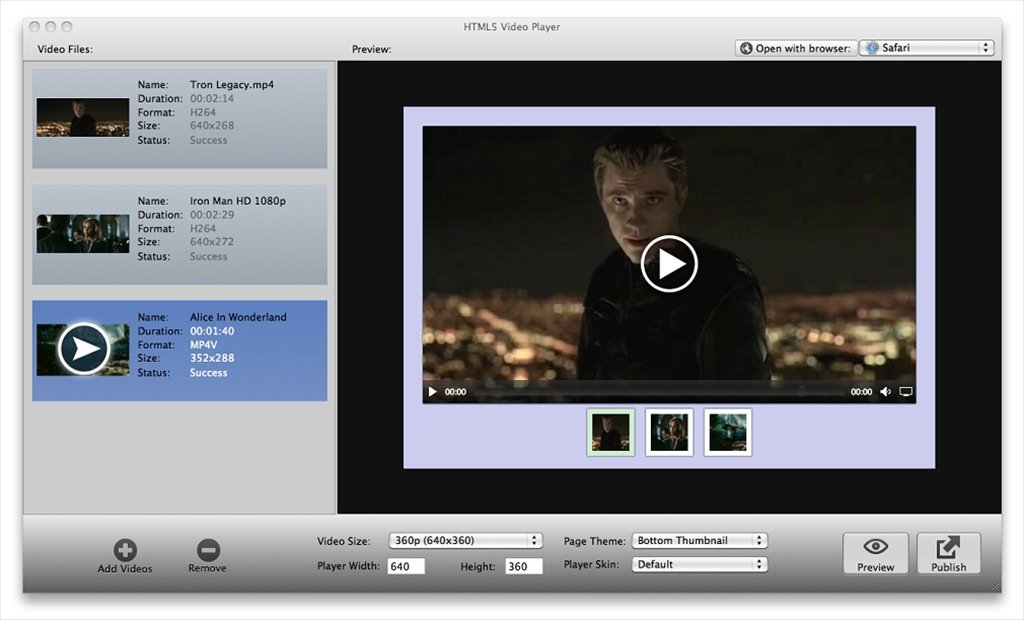
The browser can play the media, but estimates that not enough data hasīeen loaded to play the media up to its end without having to stop for The input buffer of a ScriptProcessorNode is The spec advises it to be set to metadata. The default value is different for each browser.


If set, the audio will be initially silenced. mutedĪ Boolean attribute that indicates the default setting of the audio contained in the video. loopĪ Boolean attribute if specified, the browser will automatically seek back to the start upon reaching the end of the video. The height of the video's display area, in CSS pixels (absolute values only no percentages). In Safari, you can use x-webkit-airplay="deny" as a fallback. disableremoteplayback ExperimentalĪ Boolean attribute used to disable the capability of remote playback in devices that are attached using wired (HDMI, DVI, etc.) and wireless technologies (Miracast, Chromecast, DLNA, AirPlay, etc.). Prevents the browser from suggesting a Picture-in-Picture context menu or to request Picture-in-Picture automatically in some cases. See CORS settings attributes for additional information. If invalid, it is handled as if the enumerated keyword anonymous was used. without sending the Origin: HTTP header), preventing its non-tainted use in elements. When not present, the resource is fetched without a CORS request (i.e. If the server does not give credentials to the origin site (through Access-Control-Allow-Credentials: HTTP header), the resource will be tainted and its usage restricted. In other words, it sends the Origin: HTTP header with a cookie, a certificate, or performing HTTP Basic authentication. Sends a cross-origin request with a credential. If the server does not give credentials to the origin site (by not setting the Access-Control-Allow-Origin: HTTP header), the resource will be tainted, and its usage restricted. In other words, it sends the Origin: HTTP header without a cookie, X.509 certificate, or performing HTTP Basic authentication. Sends a cross-origin request without a credential. CORS-enabled resources can be reused in the element without being tainted. This enumerated attribute indicates whether to use CORS to fetch the related video. Use the disablepictureinpicture attribute if you want to disable the Picture-In-Picture mode (and the control). The allowed values are nodownload, nofullscreen and noremoteplayback.

The controlslist attribute, when specified, helps the browser select what controls to show for the video element whenever the browser shows its own set of controls (that is, when the controls attribute is specified). If this attribute is present, the browser will offer controls to allow the user to control video playback, including volume, seeking, and pause/resume playback. autopictureinpicture ExperimentalĪ Boolean attribute which if true indicates that the element should automatically toggle picture-in-picture mode when the user switches back and forth between this document and another document or application. Chrome 70.0) autoplay doesn't work if no muted attribute is present.

To remove autoplay, the attribute needs to be removed altogether. To disable video autoplay, autoplay="false" will not work the video will autoplay if the attribute is there in the tag at all.
#HTML5 VIDEO PLAYER DOWNLOAD HOW TO#
See our autoplay guide for additional information about how to properly use autoplay. However, this can be useful when creating media elements whose source will be set at a later time, under user control. If you must offer autoplay functionality, you should make it opt-in (requiring a user to specifically enable it). Note: Sites that automatically play audio (or videos with an audio track) can be an unpleasant experience for users, so should be avoided when possible.


 0 kommentar(er)
0 kommentar(er)
